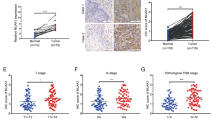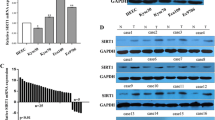Abstract
The nuclear receptor coactivator 5 (NCOA5) was a unique coactivator independent of AF2 that can modulate ERα-mediated transcription. Recent researches have indicated that its downregulation may participate in cancer development and progression. The aims of the present study were to investigate NCOA5 expression in esophageal squamous cell carcinoma (ESCC) and validate its possible influence on patients’ prognosis. NCOA5 expression was examined by immunohistochemical staining in 119 ESCC patients’ tissues. Ten paired tumor and adjacent normal specimens were examined by Western blot analysis. Statistical analysis was performed to assess its relevance with various clinicopathologic features and its influence on patients’ survival. By immunohistochemistry analysis, NCOA5 expression was found to be significantly correlated with differentiation (P = 0.039), T status (P = 0.047) and stage (P = 0.036). Furthermore, we found NCOA5 higher expression in normal tissues than in tumor tissues by Western blot analysis. Univariate analysis showed that poor differentiation (P = 0.035, P = 0.027), lymph node metastasis (P < 0.001, P < 0.001), high T status (P = 0.010, P = 0.012), advanced stage (P < 0.001, P < 0.001) and NCOA5 low expression (P < 0.001, P < 0.001) were significantly correlated with poor prognosis of both disease-free survival (DFS) and overall survival (OS). Multivariate analysis showed that NCOA5 low expression (P = 0.019, P = 0.047), high T status (P = 0.015, P = 0.012), lymph node metastasis (P = 0.040, P = 0.021) and advanced stage (P = 0.017, P = 0.046) were independent prognostic factors of poor DFS and OS. Our findings suggest that NCOA5 low expression is associated with ESCC progression and is a potential biomarker in predicting poor prognosis. Further studies of NCOA5 may help develop new therapeutic strategies against ESCC.



Similar content being viewed by others
References
Pennathur A, Gibson MK, Jobe BA, et al. Oesophageal carcinoma. Lancet. 2013;9864:400–12.
Qi Y, Chao W, Chiu J. An overview of esophageal squamous cell carcinoma proteomics. J Proteom. 2012;11:3129–37.
Pennathur A, Farkas A, Krasinskas AM, et al. Esophagectomy for T1 esophageal cancer: outcomes in 100 patients and implications for endoscopic therapy. Ann Thorac Surg. 2009;4(1048–54):1054–5.
Sauve F, McBroom LDB, Gallant J, et al. CIA, a novel estrogen receptor coactivator with a bifunctional nuclear receptor interacting determinant. Mol Cell Biol. 2001;1:343–53.
Jiang C, Ito M, Piening V, et al. TIP30 interacts with an estrogen receptor-interacting coactivator CIA and regulates C-Myc transcription. J Biol Chem. 2004;26:27781–9.
Lewis JP, Palmer ND, Ellington JB, et al. Analysis of candidate genes on chromosome 20Q12-13.1 reveals evidence for BMI mediated association of PREX1 with type 2 diabetes in European Americans. Genomics. 2010;4:211–9.
Gao S, Li A, Liu F, et al. NCOA5 haploinsufficiency results in glucose intolerance and subsequent hepatocellular carcinoma. Cancer Cell. 2013;6:725–37.
Korkaya H, Kim GI, Davis A, et al. Activation of an IL6 inflammatory loop mediates trastuzumab resistance in HER2 + breast cancer by expanding the cancer stem cell population. Mol Cell. 2012;4:570–84.
Ishimura N, Amano Y, Sanchez-Siles AA, et al. Fatty acid synthase expression in Barrett’s esophagus: implications for carcinogenesis. J Clin Gastroenterol. 2011;8:665–72.
Svensson C, Ceder J, Iglesias-Gato D, et al. REST mediates androgen receptor actions on gene repression and predicts early recurrence of prostate cancer. Nucleic Acids Res. 2014;2:999–1015.
Ischenko I, Liu J, Petrenko O, et al. Transforming growth factor-beta signaling network regulates plasticity and lineage commitment of lung cancer cells. Cell Death Differ. 2014;21:1218–28.
Li S, Tian H, Yue W, et al. Overexpression of metastasis-associated protein 1 is significantly correlated with tumor angiogenesis and poor survival in patients with early-stage non-small cell lung cancer. Ann Surg Oncol. 2011;7:2048–56.
Elinav E, Nowarski R, Thaiss CA, et al. Inflammation-induced cancer: crosstalk between tumours, immune cells and microorganisms. Nat Rev Cancer. 2013;11:759–71.
Sugimura K, Miyata H, Tanaka K, et al. Let-7 expression is a significant determinant of response to chemotherapy through the regulation of IL-6/STAT3 pathway in esophageal squamous cell carcinoma. Clin Cancer Res. 2012;18:5144–53.
Timme S, Ihde S, Fichter CD, et al. STAT3 expression, activity and functional consequences of STAT3 inhibition in esophageal squamous cell carcinomas and Barrett’S adenocarcinomas. Oncogene. 2014;33:3256–66.
Roderick JE, Tesell J, Shultz LD, et al. C-Myc inhibition prevents leukemia initiation in mice and impairs the growth of relapsed and induction failure pediatric T-ALL cells. Blood. 2014;7:1040–50.
Masui K, Tanaka K, Akhavan D, et al. MTOR complex 2 controls glycolytic metabolism in glioblastoma through foxo acetylation and upregulation of c-Myc. Cell Metab. 2013;5:726–39.
Yu L, Wu WK, Li ZJ, et al. Prostaglandin E(2) promotes cell proliferation via protein kinase c/extracellular signal regulated kinase pathway-dependent induction of c-myc expression in human esophageal squamous cell carcinoma cells. Int J Cancer. 2009;11:2540–6.
Acknowledgments
This work was partially supported by the National Natural Science Foundation of China (No. 30571844), the Science and Technology Development Foundation of Shandong Province (No. 2009GG10002007), the National Natural Science Foundation of Shandong Province (No. ZR2009CM090) and the Independent Innovation Foundation of Shandong University (2012DX005).
Conflict of interest
The authors declare that they have no conflict of interest.
Author information
Authors and Affiliations
Corresponding author
Rights and permissions
About this article
Cite this article
Chen, Gq., Tian, H., Yue, Wm. et al. NCOA5 low expression correlates with survival in esophageal squamous cell carcinoma. Med Oncol 31, 376 (2014). https://doi.org/10.1007/s12032-014-0376-y
Received:
Accepted:
Published:
DOI: https://doi.org/10.1007/s12032-014-0376-y




